#Access to Education in Rural Areas
Explore tagged Tumblr posts
Text

Play is the natural language of children, serving as an essential tool for learning and development in preschool. It fosters creativity through open-ended play experiences like building with blocks and creating artwork, which develop critical thinking and understanding of the world. Play promotes social interaction by engaging children in cooperative activities, teaching communication, negotiation, and empathy, which are crucial for forming positive relationships and teamwork. It also enhances cognitive abilities through sensory play, stimulating senses and cognitive development. Physical activity, especially outdoor play, helps develop gross motor skills and connects children with nature.
Souce - https://holytrinityschools.in/
#quality education for rural students#educational support programs#Access to Education in Rural Areas#Institute For Academic Excellence
1 note
·
View note
Text
Worst part of this fallout is that parents are going to start curtailing their female wards from any type of career that MIGHT demand late night shifts or staying alone. Tell me which workplace is fully crowded 24/7? Women go to the lavatory which are usually in an out of the way area of the workplace & it takes a less than quarter of an hour to get raped.
The phenomenon of extremely violent rape/murder of typically good-looking young women who are well educated, well placed professionally is a well thought out strategy by the saffron brigade.
Do girls, women face violent incidents in india? Absolutely. Every corner of India is unsafe for women - it's on ourselves to stay safe, which means that the female in question should never venture out after nightfall, stray anywhere without permission, etc.
But this particular phenomenon that started in the national spotlight with Nirbhaiya and continues with Dr. Mamta is subtle psychological grooming to put women back "where they belong" , take India back to the "good old days" where education, literacy and even access to basic amenities were only in the hands of a few.
She has not just been raped and murdered, she was very much tortured and brutalized like Nirbhaya. It is all over the Bengali news. I don't understand why no one is talking about this.
A 2nd year Respiratory Medicine in a well known government medical college in Kolkata, West Bengal, India is found in a semi-naked state and the college/ hospital called it a suicide.
I'm a MBBS student in second year. After reading about her, what crossed my mind is the amount of times she would have felt this fear, before this worst fear of hers eventually materialized.
"A young resident doctor was found dead in the seminar room of her medical college in Kolkata. Initial autopsy report suggests possible rape and murder."
As all are saying,
She wasn't walking the street at odd hours. She wasn't wearing clothes that were provocative. She wasn't loitering in dangerous neighbourhoods.
She was a resident doctor, looking for a place to rest in her own hospital.
She had been on duty and had gone to rest in the early hours of Friday.
The one place which was supposed to guarantee her safety failed her, miserably.
Someone comes, rapes a female pg who is merely resting in a seminar hall because there is no proper place for her to rest, brutalized her and kills her. How did NO one know? The college and police initially call it a suicide. Excuse me? It is also being said that under pressure from local politicians, the Principal and Dean attempted to alter the post-mortem report. Autopsy confirms sexual assault.

What are the actions taken? One man arrested because his behavior seemed "shady". This is clearly not an act of one man. And this was a very well aware of and a well executed criminal act.

Also, all this happening in WB right when the situation of bangladesh is in turmoil and news of Bangladeshi Hindus being killed and tortured, seems wrong, VERY WRONG. Happening right before NEET-PG, as 24 lakh doctors prepare to write an exam on Sunday to be resident doctors, this news has wrapped us all in agony and rage,
What are they working so hard for? Why should they aspire to be in a system that ignores their basic needs? The minimum requirement of a workplace is safety. That should be non-negotiable.
This profession demands extereme hardwork, a lot of mental strength and Physical Assaults, harassment, low paying jobs with odd working hours with intense humiliation. Now its the worst of all seeing a bright mind losing her life in the most disrespectful state of all. This should never happen to any woman.
I'd also like to question why isn't any big media house covering this news, where are all the international news channels all this time.
What are the students in other medical colleges doing? This talks about their own safety and lives. What are the medical students across the world doing? It's time for us to stand for the most basic Human right, safety.
Yesterday when my roommate, an MBBS final year intern was heading for her night posting, I feared and prayed for her to come back safely. Thinking about it, in a few years I will also have night posting, I'll also return from my hospital duties late at night. I'll also have to go through the same fear, and I'll also have to keep praying that my worst fears don't turn into reality. So many female doctors, nursing staffs, other Healthcare workers, other working women, non-working women go through the same fear, probably multiple times a day.
It is a shame to be born in such a disgusting world and society, it is shame to witness such a brutal crime, and it is a shame to live in this fear daily.
Those RAPISTS need to be hunged infront of the whole natio...if needed burned alive. People should fear the idea of raping, more than getting raped.
#call me crazy#taking power out of women's hands is the surest way to bring back the caste status quo#the more people fear to let their women folk out the more women will lose access to education literacy healthcare#West is only shown the brighter aspects of India's growth#women still have to opt for arranged marriages if their families forced them#women in rural areas still get married in their teens#Modi's India fits the NRI dream of a developed India on par with the West#but they don't want to see reality
1K notes
·
View notes
Text
Discover Burundi: A Hidden Gem in East Africa
A Brief History of Burundi Burundi, a small landlocked country in East Africa, has a rich and complex history. The region has been inhabited for thousands of years, with evidence of human settlement dating back to the Neolithic period. The Kingdom of Burundi was established in the 17th century, ruled by a monarch known as the mwami. The kingdom maintained its independence until the late 19th…

View On WordPress
#1962. The post-independence period was marked by political instability#A Brief History of Burundi#a small landlocked country in East Africa#Accommodation in Burundi ranges from budget hostels to mid-range hotels and a few high-end options. Prices are generally affordable#Activities for Tourists in Burundi#adventure#africa#although political tensions remain.#and civil conflict#and political tensions continue to influence its stability. It&039;s advisable to stay updated on the current political situation before tr#Beach Activities#Bujumbura#Burundi#Burundi gained independence from Belgium on July 1#Burundi has been working towards peace and stability#Burundi is predominantly Christian#Burundi Roads#Burundi&039;s political situation has been tumultuous#but challenges remain. The country is governed as a presidential republic#but it&039;s advisable to check the latest requirements with the nearest Burundian embassy before traveling.#but rural areas may have limited access and poor road conditions.#but rural roads can be challenging#challenges such as insufficient infrastructure and teacher shortages persist. Secondary and higher education are also developing#control was transferred to Belgium under a League of Nations mandate.#Cost of living in Bujumbura#Cost of Living in Burundi#Cultural Tours in Burundi#destinations#Discover Burundi: A Hidden Gem in East Africa#Do I need a visa to visit Burundi?
0 notes
Text
#INDUSTRIES#VALUES#TRAITS#3E-Dedication#3E-Empowerment#3E-Accesibility#3E-Equality#3E-Creativity#3E-Achievement#3E-Inclusion#3E-Motivation.#TENSIONS#3E-Inequality of educational opportunities in rural Australia#3E-Stigma attached to higher education in regional areas#3E-Lack of quality education in rural areas#3E-Attrition rates of students in Country Universities Centre#3E-Accessibility of higher education to underprivileged students in outback NSW.
0 notes
Text
i really do think there’s a huge disconnect on here w/ people who have never used tiktok as to what it actually is and who actually uses it. the number of people i’ve seen call it a “teen dancing app” is actually insane. it has not been a teen dancing app since i was in high school, around 2016 - 2020. the main communities i saw on a daily basis were 1) black history/anti-racism educators, 2) high school & college teachers sharing in-classroom strategies and frustrations with the education system, 3) local/state political leaders giving real-time updates on behind-the-scenes government decisions, & 4) community activism & leadership. like tiktok is an adult platform. almost every person i interacted with was my age or older. and yes it completely depends on your fyp and how you interact with the app, yes there’s still teenagers and dance videos and literally anything else you can think of. but these communities of adults aren’t insubstantial at all, they have literally millions of interactions on a daily basis. there’s about a million other types of communities that i could name just off the top of my head, because the range of users was SO diverse and thriving. it’s a long-distance community tool, just like any other social media—and honestly much better than any other social media, because it relies primarily on the kindness of strangers. i saw at least 5-10 videos today of queer people in rural areas panicking because they don’t have any access to queer community on any other platform or in real life. and before i end this i do want to say i think tiktok is coming back, i think this is a highly orchestrated political move, etc., but i do know it won’t ever be exactly the same. people are panicking about free speech violations because tiktok was a place where people fucking SPEAK. i have never seen mass mobilization and communication in this same way for as long as i’ve been alive. it is the people’s app, not just a silly teenage thing. if you’re not on tiktok and never have been, please stop talking about it like you know anything at all😭
#idec if i look stupid for these posts i am fucking Mad#it’s not about doomscrolling. be so fr. i’ve had a time limit on for years and i’ve done perfectly fine#people’s jobs were on this app. small businesses were on this app. fucking CULTURE was on this app#project willow? bisan in gaza? like this is the most interconnected and fast-moving source of news we have#literally straight from the ground. from the places where it’s happening#i know i can still read news. that’s not the problem.#the problem is that i have nowhere else to see the videos from my minnesota legislator who’s been giving daily updates on the republican#coup in the house of representatives. like. do you see the problem.#not to mention half the news sites are paywalled anyway.#and i saw someone say that this forces us to foster irl community which is true again. but you can still have irl community at the same time#as long-distance virtual community????#my best friends are long distance. if all social media went dark i could never talk to them again.#like we are in the fucking 21st century. we should be able to have both.#anyway. sorry for all the ranting lately except i’m really not because i am fucking PISSED#i’ll be on rednote and youtube for a while except neither of them are really the same.#genuinely nothing was like tiktok fr. i miss it already#tiktok#tiktok ban
627 notes
·
View notes
Text
NASA Inspires Your Crafty Creations for World Embroidery Day
It’s amazing what you can do with a little needle and thread! For #WorldEmbroideryDay, we asked what NASA imagery inspired you. You responded with a variety of embroidered creations, highlighting our different areas of study.
Here’s what we found:
Webb’s Carina Nebula
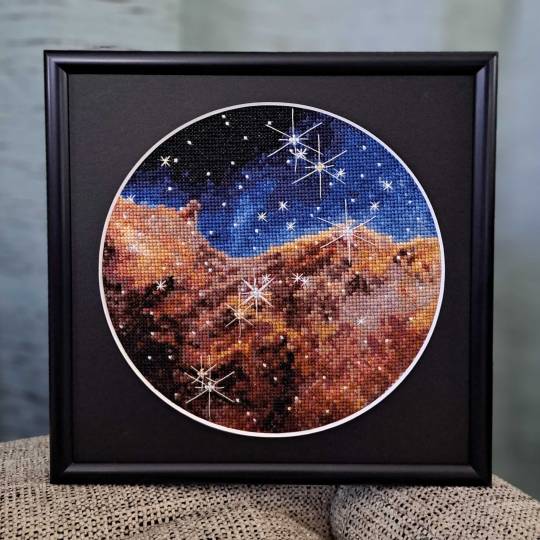
Wendy Edwards, a project coordinator with Earth Science Data Systems at NASA, created this embroidered piece inspired by Webb’s Carina Nebula image. Captured in infrared light, this image revealed for the first time previously invisible areas of star birth. Credit: Wendy Edwards, NASA. Pattern credit: Clare Bray, Climbing Goat Designs
Wendy Edwards, a project coordinator with Earth Science Data Systems at NASA, first learned cross stitch in middle school where she had to pick rotating electives and cross stitch/embroidery was one of the options. “When I look up to the stars and think about how incredibly, incomprehensibly big it is out there in the universe, I’m reminded that the universe isn’t ‘out there’ at all. We’re in it,” she said. Her latest piece focused on Webb’s image release of the Carina Nebula. The image showcased the telescope’s ability to peer through cosmic dust, shedding new light on how stars form.
Ocean Color Imagery: Exploring the North Caspian Sea
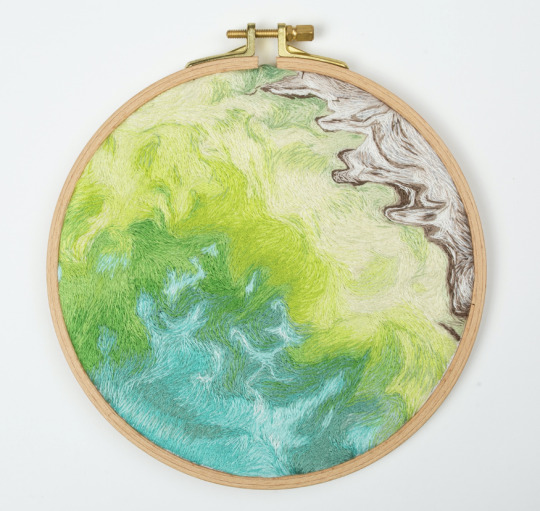
Danielle Currie of Satellite Stitches created a piece inspired by the Caspian Sea, taken by NASA’s ocean color satellites. Credit: Danielle Currie/Satellite Stitches
Danielle Currie is an environmental professional who resides in New Brunswick, Canada. She began embroidering at the beginning of the Covid-19 pandemic as a hobby to take her mind off the stress of the unknown. Danielle’s piece is titled “46.69, 50.43,” named after the coordinates of the area of the northern Caspian Sea captured by LandSat8 in 2019.

An image of the Caspian Sea captured by Landsat 8 in 2019. Credit: NASA
Two Hubble Images of the Pillars of Creation, 1995 and 2015
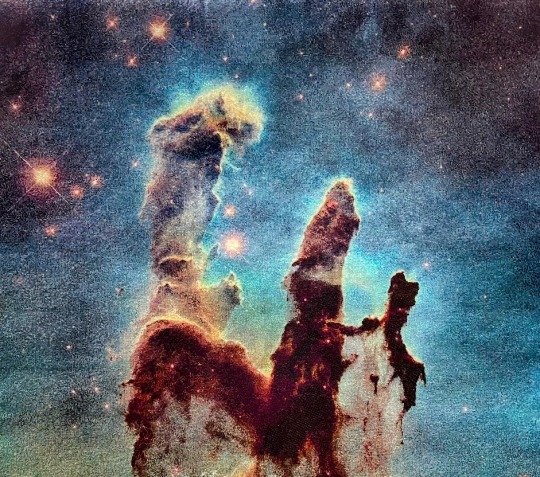
Melissa Cole of Star Stuff Stitching created an embroidery piece based on the Hubble image Pillars of Creation released in 1995. Credit: Melissa Cole, Star Stuff Stitching
Melissa Cole is an award-winning fiber artist from Philadelphia, PA, USA, inspired by the beauty and vastness of the universe. They began creating their own cross stitch patterns at 14, while living with their grandparents in rural Michigan, using colored pencils and graph paper. The Pillars of Creation (Eagle Nebula, M16), released by the Hubble Telescope in 1995 when Melissa was just 11 years old, captured the imagination of a young person in a rural, religious setting, with limited access to science education.
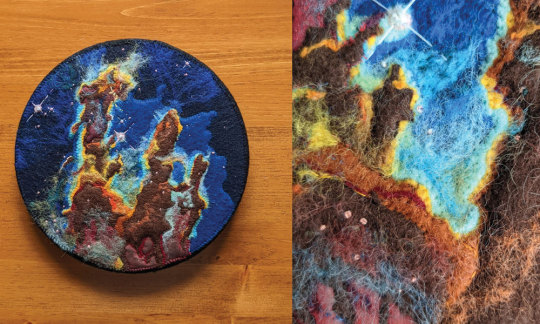
Lauren Wright Vartanian of the shop Neurons and Nebulas created this piece inspired by the Hubble Space Telescope’s 2015 25th anniversary re-capture of the Pillars of Creation. Credit: Lauren Wright Vartanian, Neurons and Nebulas
Lauren Wright Vartanian of Guelph, Ontario Canada considers herself a huge space nerd. She’s a multidisciplinary artist who took up hand sewing after the birth of her daughter. She’s currently working on the illustrations for a science themed alphabet book, made entirely out of textile art. It is being published by Firefly Books and comes out in the fall of 2024. Lauren said she was enamored by the original Pillars image released by Hubble in 1995. When Hubble released a higher resolution capture in 2015, she fell in love even further! This is her tribute to those well-known images.
James Webb Telescope Captures Pillars of Creation

Darci Lenker of Darci Lenker Art, created a rectangular version of Webb’s Pillars of Creation. Credit: Darci Lenker of Darci Lenker Art
Darci Lenker of Norman, Oklahoma started embroidery in college more than 20 years ago, but mainly only used it as an embellishment for her other fiber works. In 2015, she started a daily embroidery project where she planned to do one one-inch circle of embroidery every day for a year. She did a collection of miniature thread painted galaxies and nebulas for Science Museum Oklahoma in 2019. Lenker said she had previously embroidered the Hubble Telescope’s image of Pillars of Creation and was excited to see the new Webb Telescope image of the same thing. Lenker could not wait to stitch the same piece with bolder, more vivid colors.
Milky Way
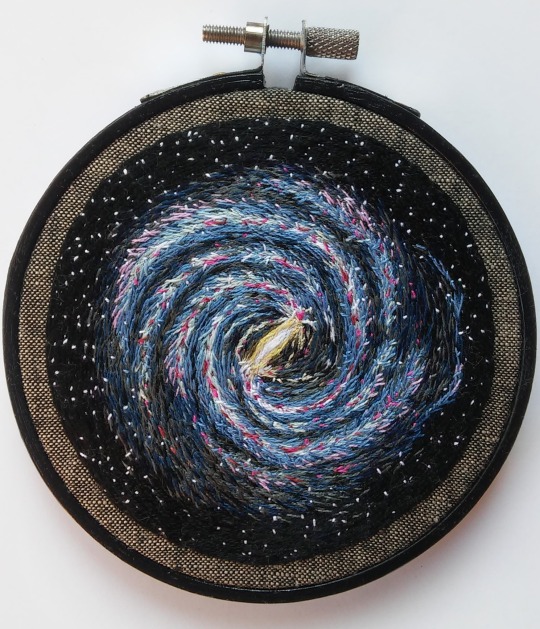
Darci Lenker of Darci Lenker Art was inspired by NASA’s imaging of the Milky Way Galaxy. Credit: Darci Lenker
In this piece, Lenker became inspired by the Milky Way Galaxy, which is organized into spiral arms of giant stars that illuminate interstellar gas and dust. The Sun is in a finger called the Orion Spur.
The Cosmic Microwave Background
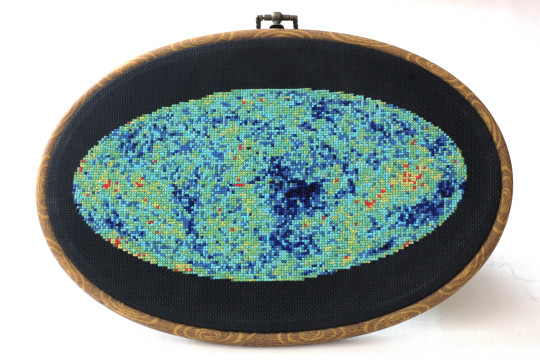
This image shows an embroidery design based on the cosmic microwave background, created by Jessica Campbell, who runs Astrostitches. Inside a tan wooden frame, a colorful oval is stitched onto a black background in shades of blue, green, yellow, and a little bit of red. Credit: Jessica Campbell/ Astrostitches
Jessica Campbell obtained her PhD in astrophysics from the University of Toronto studying interstellar dust and magnetic fields in the Milky Way Galaxy. Jessica promptly taught herself how to cross-stitch in March 2020 and has since enjoyed turning astronomical observations into realistic cross-stitches. Her piece was inspired by the cosmic microwave background, which displays the oldest light in the universe.

The full-sky image of the temperature fluctuations (shown as color differences) in the cosmic microwave background, made from nine years of WMAP observations. These are the seeds of galaxies, from a time when the universe was under 400,000 years old. Credit: NASA/WMAP Science Team
GISSTEMP: NASA’s Yearly Temperature Release
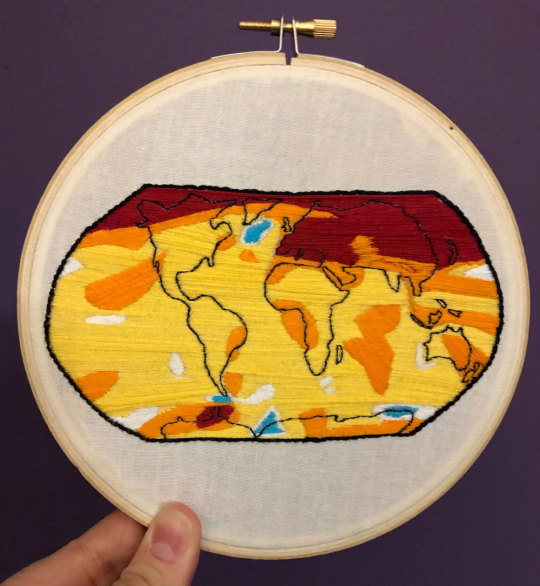
Katy Mersmann, a NASA social media specialist, created this embroidered piece based on NASA’s Goddard Institute for Space Studies (GISS) global annual temperature record. Earth’s average surface temperature in 2020 tied with 2016 as the warmest year on record. Credit: Katy Mersmann, NASA
Katy Mersmann is a social media specialist at NASA’s Goddard Space Flight Center in Greenbelt, Md. She started embroidering when she was in graduate school. Many of her pieces are inspired by her work as a communicator. With climate data in particular, she was inspired by the researchers who are doing the work to understand how the planet is changing. The GISTEMP piece above is based on a data visualization of 2020 global temperature anomalies, still currently tied for the warmest year on record.
In addition to embroidery, NASA continues to inspire art in all forms. Check out other creative takes with Landsat Crafts and the James Webb Space telescope public art gallery.
Make sure to follow us on Tumblr for your regular dose of space!
#NASA#creativity#fiber art#embroidery#art#art challenge#needlework#crafts#handmade#textile art#cross stitch#stitching#inspiration#inspo#Earth#Earth science#Hubble#James Webb Space Telescope#climate change#water#nebula#stars
6K notes
·
View notes
Text
Things Biden and the Democrats did, this week. #6
Feb 16-23 2024
The EPA announced 5.8 billion dollars in funding upgrade America's water systems. 2.6 billion will go to wastewater and stormwater infrastructure, while the remaining $3.2 billion will go to drinking water infrastructure. $1 billion will go toward the first major effort to remove PFASs, forever chemicals, from American drinking water. The Administration all reiterated its plans to remove all lead pipes from America's drinking water systems, its spent 6 billion on lead pipe replacement so far.
The Department of Education announced the cancellation of $1.2 billion in student loan debt reliving 153,000 borrowers. This is the first debt cancellation through the Saving on a Valuable Education (SAVE) Plan, which erases federal student loan balances for those who originally borrowed $12,000 or less and have been making payments for at least 10 years. Since the Biden Administration's more wide ranging student loan cancellation plan was struck down by the Supreme Court in 2023 the Administration has used a patchwork of different plans and authorities to cancel $138 billion in student debt and relieve nearly 4 million borrowers, so far.
First Lady Jill Biden announced $100 million in federal funding for women’s health research. This is part of the White House Initiative on Women’s Health Research the First Lady launched last year. The First Lady outlined ways women get worse treatment outcomes because common health problems like heart attacks and cancer are often less understood in female patients.
The Biden Administration announced 500 new sanctions against Russian targets in response to the murder of Russian dissident Alexei Navalny. The sanctions will target people involved in Navalny's imprisonment as well as sanctions evaders. President Biden met with Navalny's widow Yulia and their daughter Dasha in San Francisco
The White House and Department of Agriculture announced $700 Million in new investments to benefit people in rural America. The projects will help up to a million people living in 45 states, Puerto Rico, and the Northern Mariana Islands. It includes $51.7 million to expand access to high-speed internet, and $644.2 million to help 158 rural cooperatives and utilities provide clean drinking water and sanitary wastewater systems for 578,000 people in rural areas.
The Department of Commerce signed a deal to provide $1.5 billion in upgrades and expand chip factories in New York and Vermont to boost American semiconductor manufacturing. This is the biggest investment so far under the 2022 CHIPS and Science Act
the Department of Transportation announced $1.25 billion in funding for local projects that improve roadway safety. This is part of the administration's Safe Streets and Roads for All (SS4A) program launched in 2022. So far SS4A has spent 1.7 billion dollars in 1,000 communities impacting 70% of America's population.
The EPA announced $19 million to help New Jersey buy electric school buses. Together with New Jersey's own $45 million dollar investment the state hopes to replace all its diesel buses over the next three years. The Biden Administration's investment will help electrify 5 school districts in the state. This is part of the The Clean School Bus Program which so far has replaced 2,366 buses at 372 school districts since it was enacted in 2022.
Bonus: NASA in partnership with Intuitive Machines landed a space craft, named Odysseus, on the moon, representing the first time in 50 years America has gone to the moon. NASA is preparing for astronauts to return to the moon by the end of the decade as part of the Artemis program. All under the leadership of NASA Administrator, former Democratic Senator and astronaut Bill Nelson.
#Thank Biden#Joe Biden#student loans#student loan forgiveness#climate change#climate crisis#Russia#Alexei Navalny#women's health#NASA#odysseus#moon landing#good news#Democrats#Politics#us politics
714 notes
·
View notes
Note
Thank you for reporting on this InstaJock app. It's been helpful to get more information. I work in healthcare and a lot of people ask me about it. So much so that I downloaded it myself to explore the app's features. I wouldn't use it on myself though. I just graduated from med school and I'm not about to waste that education. But one thing I've noticed is this "location feature" where it seems the quality of the jock it might change you into has to do with your surroundings. I have to drive through some more rural parts to get back home and the number of redneck jocks here is freaky. Wondering if you've got more insight into all that.
I’m really glad that my work has been helpful, and I’m also very impressed that you know so much about the app. I’ve never met another person who was able to get the app without falling into its enchantment. You must have protections like I do, or an incredibly strong will. I’m surprised people are interested in the app for healthcare reasons, but I suppose it makes sense. InstaJock turns anyone who uses it into a jock instantly, and jocks are muscular and healthy as shit. If I had to choose between being deathly ill and a dumb jock, I might do the same thing. But we’ll explore the interesting connection between InstaJock and healthcare some other time. Today let’s look at the location feature.
You’ve basically got it all figured out. InstaJock has a feature that tracks your location and turns you into a certain type of jock based on where you are. Or, more accurately, where you spend a lot of time, since it accesses your location history too. Just like all the features it can be turned on and off when setting up an account, or in settings afterwards, but unlike other features it is usually turned on to begin with. It makes sense when you think about it. The app may turn the user into a jock, but they’re still a version of themselves. So their new self should reflect their surroundings. Since you’re in a rural area, it seems most of the InstaJock users there would become redneck jocks.
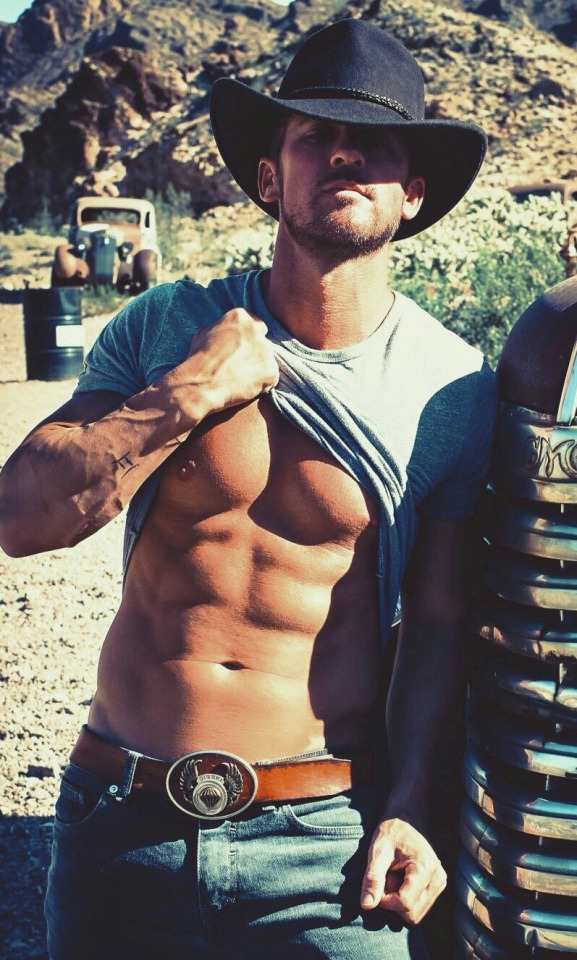
It is strange that you’re seeing so many though. InstaJock is meant to spread, but… not that quickly. A guy gets turned by the app, maybe invites a couple of his old nerdy friends, and then enjoys being a buff, dumb, sexy jock. The jocks aren’t organized or intelligent enough to turn people on mass. So… someone must be directing them, telling them what to do. They’d have to be smart, but someone the jocks would listen to. There are only a handful of people who could do that. It’s probably the same person whose been using the app to torment nerds, who tricked that nerdy frat president into turning himself, who told that bullied kid InstaJock could help him steal muscles.
I have some theories on who it is. But I shouldn’t say anything until I have more proof. Be careful though. If it’s who I think it is, then our protections… may not keep either of us safe for long.
171 notes
·
View notes
Text
Fan Labor Offerings
We've had 67 offers for fan labor so far - everything from SPag and cheerleading, to translations in 5 languages, to sensitivity reading for head injuries, to specialist knowledge of camp counseling and US law, to offers for custom AO3 skins and podfic editing - and LOADS more.
Under the cut you'll find the full list, but just as a preview we've got:
Translation in five different languages
Specialists offering their unique knowledge on 15 professions, 15 hobbies, and a variety of medical conditions and subcultures
Sensitivity readers on ten different topics, mainly medical issues and LGBTIA+ topics
Cultural knowledge of eight areas of the US plus seven other countries and two religions
Editing a variety of mediums
Read on for the full list - and stay until the end for some of the more unique offers!
Specialist knowledge offers:
Professional- Academia (US) American legal system/bar exam/practicing law Camp counselor Civil engineering Drafting legislation for local government (American) Employment in movie theaters Forensic science/crime scene investigation/autopsy Funeral services/embalming Medical field expertise: operating room nurse, inpatient/outpatient, emergency and wards Public libraries Small business/environmental/real estate/contracts/and general business law (American) Social media and TV/Film production work Theatre Theme/amusement park (there is a difference!) operations
Medical issues including: Ehler Danlos, surgery, escoliosis, partial disability, poor eyesight, migraines, diabetes, stroke, intellectual disabilities, physical disabilities, and experience with hospitalization
Educational info on charter schools, language immersion education, and US public education
Hobbies- Camping/hiking Chess Choir Classical music, specifically opera Film Geocaching Historical literature Horse care & general equestrian activities Music Musical instruments (guitar, ukulele, handbells) Pet ownership of multiple species/breeds Sewing, tailoring, alterations, fashion history and flat pattern-making Sports culture (US) Textile crafts (esp knitting and mending) Voice and vocal technique
Subcultures including BDSM and leather/kink, Goth, and j-fashion.
Sensitivity reading offers:
ADHD Aromanticism Asexuality Autism Blindness including: accessibility, Braille education, experience with ablism and activism, experience with assistive devices, guide dog use, rehabilitation services, navigating with or without white cane Butch/femme (esp. stone) Genderqueer Head injuries LGBTQ+ Transmasc/non-binary gender identities and/or social/medical/legal gender transitions
Cultural knowledge offers:
Australian American Chinese diaspora British culture/history Catholicism China Columbian culture/Latine culture German culture Judaism Mexican culture United States (Baltimore, Maryland; Illinois; southern California/greater Los Angeles; Great Lakes region; Pacific Nortwest; Upper Midwest; small town/rural college) Taiwan
Translation offers:
Catalan/English French/Catalan French/English German/English Spanish/Catalan Spanish/English Spanish/French Spanish (Latin-American)/English Limited English/Classical Latin
Other fan labor offers:
Typesetting a fic for printing/binding Commenting! Podfic editing Historical research assistance/developing research methodology Book review Custom AO3 workskin Basic AO3 coding Podfic mentoring/tutoring/coaching using Audacity
You guys know So Much. We're so lucky you're all so willing to share!
Want to join us? Sign ups are open until Sunday Feb 2!
87 notes
·
View notes
Text

Different types of preggy wizards!
Potion Master
Many ingredients and spell/potion components actually grow quite abundantly within the human body, and with a few basic protective charms and spells, a natural or artificially created womb is perfect for the job. Potion Masters often prefer to grow their ingredients themselves to ensure the quality meets their strict standards. A Potion Master can be spotted by their usual uniform: thick dragon-hide gloves, face protection (usually in the form of a hood or eyeglasses, which are then charmed to protect the entire head), and low-cut robes that provide easy access to their chest.
Despite not carrying any progeny that would need to be breast-fed, the human body often insists on producing milk anyway. As it would turn out, many potions, from common recipes to rare concoctions, either require breast milk or breast milk can be substituted for certain ingredients (which is an extremely rare phenomenon regarding potions ingredients, most teachers ban any substitutions at all unless it's breast milk). The low cut robes provide easy access to an oft used ingredient. Busy Potion Masters will often find their breasts engorged, their bodies will quickly adapt to the demand and begin to oversupply to compensate.
Academic
These wizards deal mostly in theory and controlled magical experiments. Little experience, or even desire to go, out in the field. Possibly the most common stereotype of a wizard, they're often found in libraries combing through stacks of old tomes. Because of this, many rich or noble families who desire to have more magical talent in their bloodlines will ask academic wizards to surrogate for them. It's a bit of extra money for their research, and it's not like they have to do much standing or walking when they can use magic to summon the books or supplies they need.
Over time, academic wizards have become very prideful of their surrogate work. Competing with other academics as to how many offspring they can carry, how long they can carry them, and even keeping tabs on the surrogate children to see who produced the most magically talented. They can also be spotted by an abundance of jewelry, often gifted in addition to their hefty surrogate contract payments, they proudly display, rather than use as spell components, as a mark of how many surrogacies they've completed.
Adventurer
While academic wizards often fit the wizard stereotype, adventurer wizards are the opposite. They live a life that's freer and less structured than most other wizards, and some even tend to be 'looser' than most wizards. Being more exposed to the world, it's variety and temptations, adventurer wizards often end up impregnated by accident, whether by a fight with slimes gone wrong or by a single night of 'drinking and dancing' with one of their party mates, just to name a few examples. Pregnant adventurer wizards are often looked down upon by the rest of wizard-kind, both for the lack of family planning and for the often mismatched outfits they sport, often dressing in whatever they can fit in, as it's hard to find a good tailor who can keep up with their growth and their traveling schedule.
Adventurer wizards often end up settling down outside of the big cities or universities most wizards call home. They usually settle down soon after giving birth. Perhaps not after the first time, or even the second, but usually somewhere between the third and fifth time; when it gets too strenuous, or depending on the location, too dangerous to travel with a party full of young children. Although there are a few who adapt to living in caravans, their ever growing family housed in a series of magically connected and protected caravans they use to continually travel the world in.
Satellite schools or small independent schools are often started by adventurer wizards, giving people in rural and wild areas access to a magical education they would otherwise have to move far away to even get a chance at getting. They are known to teach more practical magic, giving those who then wish to move to more traditional schools an excellent educational baseline. While adventurer wizards may be looked down upon for being "dirtier" from traveling and "sluttier" than most wizards, some of the greatest academic wizards of the day were taught by adventurer wizards. Even if an adventurer wizard does fit the stereotype of mismatched travel worn clothes with a heavy belly, a baby on their hip, and a toddler at their ankles; doesn't mean their contributions to magic and magical education should be disregarded.
Royal Wizard
Many kingdoms require that Royal Wizards have a minimum number of children. The reason is that a wizard who is so powerful as to obtain the status of a Royal Wizard needs to spread their genes and produce a few other powerful magic welders to pass on their power. Adventurer wizards promoted to this position may have already fulfilled that requirement, but since children born as surrogates dont count, academic (and other types of wizards) immediately feel the pressure of this new duty weighing them down. Of course, a Royal Wizard can always leave the child bearing to a partner or so, but in the past, this has left room for doubt of parentage. To prevent the disasters a court drama like that can bring (royals are very big on the whole 'bloodlines' thing), Royal Wizards often just choose to carry the required offspring themselves.
One often can't become a wizard powerful enough to be promoted to a Royal Wizard without a good amount of hubris. And in their hubris, most newly appointed Royal Wizards choose to carry all the offspring they're required to produce in one single pregnancy, despite the warnings of the Royal Wizards that preceded them. They always think they'll be the ones to perfect it, or do it better, or weave just the right combination of spells to alleviate the struggles of previous, 'obviously inferior,' Royal Wizards. Most come to regret this decision around the time the second trimester hits.
It certainly doesn't help that a Royal Wizards pregnancy may take much longer than the average wizard's due to having to pause their pregnancies due to the importance of their work. If a kingdom is at war, it wouldn't do to have your most powerful wizard at risk of going into labor at any moment. Or so gravid they cannot stand to give their speech at a peace conference. There are a thousand different situations, either real, fabricated by the ruler they serve, or even fabricated by the wizard themselves, that force a Royal Wizard to put their pregnancy on pause until it's convenient for them to finish growing their brood and allow labor to commence. While one might assume a Royal Wizard would only have to endure this once in their lifetimes, several kingdoms do have bylaws that state a Royal Wizard must conceive the required amount of children for each new ruler that ascends the throne. Conceive, not birth, which prevents the Royal Wizard from simply pausing their pregnancy at the end of a rulers life. This is most common in kingdoms with high turnover in leadership, or those with bylaws requiring the reigning ruler to be the one to breed their Royal Wizard.
#the Royal Wizard pictured has finally found the time in their busy schedule to hit the 3rd trimester and boy they are FEELING it#my ramblings#my art#nbpreg#nbpreg belly#nbpreg art
60 notes
·
View notes
Text
Why the fight for queer rights isn't over (it should be obvious, but to some people it isn't)
TW: transphobia and homophobia
Hi, Tumblr, this is Asmi. If you know me, it's probably as the Good Omens Mascot, which is flattering. I've found so much love and queer positivity in the good omens fandom, and the beautiful thing is how it's canon. Many people outside the queer community don't realise how crucial media and communities like this are. Right now since I'm on break from education, I'm on tumblr for most of the time I'm awake (which is not a lot, I nap more than Crowley). It's wild how different it is from the real world, that I live in at least.
I'm sure a lot of you might have had a similar experience to this: Basically, two people in my life, my bio father and my ex, both told me to my face that queer people needed to stop calling themselves oppressed and how now it's queer people who hold all the power and are oppressing other people. With all due respect, what the fuck.
I live in India, and being a trans guy who is bi and aspec, it's a cesspit. While I'm gendered correctly on Tumblr, and people are so loving and supportive, in real life even my friends who say they support me misgender me 90% of the time. Same with my family. In my previous college which I had to leave because of bullying by both the students and admin, even the queer students would misgender me (I told them I used they/them pronouns, because he/him would have been too unsafe, but even that they didn't manage). In the college I'll join next, it won't be safe for me to be out at all, at risk of losing opportunities and safety. Gay marriage is still illegal. Homophobia and transphobia is the norm. This doesn't even cover all the daily indignities like queerphobic jokes, casual discourse on whether or not we deserve rights, etc. Discrimination against aroace-spec people is rampant even within the queer community, worldwide.
And I live in an urban area, one of the largest cities in India known for its progressiveness and for being relatively safe for queer people. I am privileged compared to other queer people here. The story in other cities, in rural areas which make up most of the country, is far more horrifying. I'm unqualified to speak about anything other than my own experience, but if you can (if you are in a stable and calm enough mental state to handle the information, please put your mental health first) I'm sure there are first person accounts on the many forums.
The fight for equality is not over. It doesn't end with laws riddled with loopholes, it doesn't end even with laws that genuinely help the queer community. Aside from the huge problems of living safely and with access to equal opportunities and resources for people, we deserve dignity, peace, and the right to feel accepted and that we're not an abnormality. And so much more.
I haven't said anything that hasn't been said before, but it can't be said enough. To the queer people reading this, take all my love. We need to stand together, eliminate discourse over who is queer enough to be queer, and be the safe space that the world will not provide for us.
It's not over, and it hasn't been won by a long shot, but what matters is that we're fighting. Even existing as ourselves in a world that tells us it is a crime, is defiance and a step towards making this right.
#asmi#lgbtqia#good omens fandom#queer media#queer tv shows#good omens mascot#weirdly specific but ok#maggots#queer tv#gay#lesbian#transgender#intersex#nonbinary#aromantic#asexual#aroace#queer rights#bisexual#aspec#transmasc#transfem#trans pride#pride#queer#queer community#agender#lgbtq#pansexual#gender affirmation
390 notes
·
View notes
Text
End Prosecutions Targeting Kurdish Language Activities in Türkiye
Case Equating Kurdish Education with Terrorism an Abuse of Law

Rıfat Roni has spent more than a decade as an official court interpreter facilitating communication for Kurdish speakers in legal proceedings. This week, he found himself in the dock facing charges.
Roni, 59, stood trial on the widely used charge of “membership of an armed organization” on the basis of his involvement in a civil society group, the Mesopotamian Language and Culture Research Association (Med-Der), which offers Kurdish language classes and other activities to promote Kurdish linguistic rights.
The case against Roni is just one among a slew of outrageous cases over the past year in which Kurdish language songs, dances, and promotion of cultural and linguistic rights have been interpreted by the police and prosecutors as evidence of links with terrorism. The prosecutor claimed Roni’s Kurdish language activities and teaching were serving the aims of the armed Kurdistan Workers’ Party (PKK). Drawing on vague witness testimony but no concrete evidence of criminal activity, the prosecutor concluded the aim of associations like MED-DER was “to secure recruitment of youths to the rural areas [PKK militant recruitment] by using Kurdish language and winning over youths to the ideology of the PKK armed terrorist group”.
Kurdish language classes are barely accessible to most school children in the national education system in Türkiye, even though by law they should be available as a two-hour per week elective option. Associations like MED-DER have tried to offer Kurdish language classes to fill this gap. Despite Roni’s prosecution, MED-DER continues to operate as a legally registered and regularly audited association.
41 notes
·
View notes
Text
MAME & BL Literacies (Part 4)
Other parts: Part 1 | Part 2 | Part 3
Contents:
MAME’s queer characters and their lives
Fetishization of queer men and profiting off LGBT community
Why other queer genres like gei comi struggle to get live action adaptation?
(bonus) What Did You Eat Yesterday sexy times
BL and rape culture
Everyday ethnocentrism & BL
-
This is the last part of this essay series. In this part, I want to discuss the response this review of TharnType by @waitmyturtles generated. As always, corrections and criticisms are welcome.
-
Here are the points @solitaryandwandering raised:
1. fans will get SO rabid for MAME’s stuff yet resist tuning in for more queer-friendly Taiwanese BL or lower heat fare
I think that the BL MAME creates is "queer-friendly". Moreover, her BL focuses on the intersection of queerness with local forms of gender, patriarchy & heterosexism, class, race, skin color, age, employment, location & regionalism, abilities and disabilities, education, health conditions and access to medical care, urban-rural divide, migrant status, culture, etc.
MAME's BL have aspects of Thai queer culture and praxis that are otherwise overlooked. Here's an example.
Through Techno’s interaction with Tharn in episode 1 of TharnType, MAME highlights an important issue: invisibility of androphilic “man”. Techno comments that Tharn is the first masculine presenting androphilic male he has met, even though he has several queer friends.
This is in part due to skewed presence of androphilic male characters in mainstream media. In Thai soap operas and movies, androphilic men are 'presented as effeminate, overreactive, with a passionate but unrequited interest in men'.
Countering this perception is the hegemony of masculine aesthetics in urban Thailand’s queer culture. 'The English word “man” has been borrowed into Thai gay-speak to denote acting in a masculine way. Man describes a masculine presentation of either gay-identified or heterosexual males and contrasts with the Thai term phu-chai, which also translates as “man” but is used in the specific sense of denoting the gender role of a heterosexually identified male.
'Many Thai gays believe that effeminate gay men, or gay sao, will experience discrimination and prejudice because of their feminine characteristics and behaviours. Thai gays also think that performing gender-normative forms of manhood are useful in establishing sexual and romantic relations with other gays. These expectations are associated with the culture of images, known in Thai as phap-phot, by which many homosexual men feel compelled to act in accord with normative male gender roles.'
This is in contrast to Techno’s queer friends who blur the lines between the masculine and feminine domains. His use of the word kathoey is case in point.
Moreover, the need for social conformity for Thai gays in terms of their gender performance is an urban phenomenon. Ethnographic study by Wijngaarden traced the rapid adoption of more masculine gender performance by gay men who moved from rural setting to urban for the purpose of education and employment. Ambiguity in gender performance is more accepted in rural setting where there is gender-based understandings of homosexuality. Also, gay dating scene in urban areas seem to assign value to masculine presentation.
source
I don't really know what @solitaryandwandering mean by "queer-friendly" in the context of Taiwanese BL.
Support of fu-people (BL fans) for queer works in Taiwan is well-known. When the play 《愛情生活》 Life of Love by Xu ZhengPing was staged, they had BL version shows too.
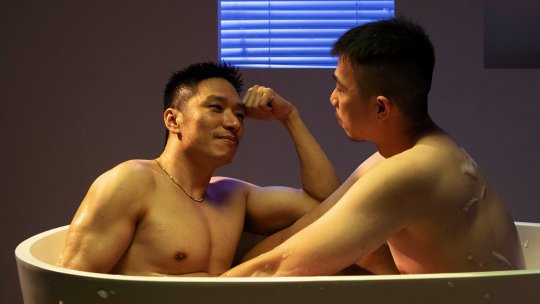
The play has a short film adaptation which is available for free on GagaOOLala.
youtube
Fu-people have also shown their support for series like Breakfast by 想再見你.
-
@solitaryandwandering gave valuable response to this post which I am adding below.
I had to go back and re-read what I said in the post for more context. I think though we may disagree on a couple points (what people consider "queer-friendly" is somewhat subjective) your criticisms are totally valid. I think in my first point I was making a really broad generalization and my description of overall Taiwanese BL as being "more" queer-friendly largely rings false to me now. I think what I was frustrated with was more with what I've seen of BL fandom's response to the series and other works. The popularity of high heat and "problematic" themes (I'm using that pretty liberally) like abusive relationships or rape is pretty massive in comparison to Taiwanese stuff in general. But that's not to say Taiwanese stuff don't utilize the same tropes or themes. Hence why I think my comparison wasn't accurate.
In comparing Taiwanese BL I had seen at the time and MAME's stuff (specifically TharnType) I probably felt that Taiwanese BL didn't so heavily utilize themes which made me uncomfortable or angry at the way MAME was writing it. And I still do largely think that at least for her earlier stuff MAME needed to work on her characters and plots. I did not see Tharn or Type or the other characters or the story as appealing or positive representations of… anything. In my view at the time Taiwanese BL liked to play with similar themes but still (mostly) didn't leave me with a bad taste in my mouth. I don't really agree with what I think was a bit of a limited view at the time. Reading your post has given me a bit of a different perspective, too.
I don't think everyone making Taiwanese BL particularly cares about the response queer fans have haha. And MAME has shown she does, at least from my perspective.
And again lumping an entire country's slant on the genre against MAME's creations is a bit disingenuous. So I appreciate you criticizing that.
And I don't inherently think lower heat stuff is inherently more queer-friendly of course - queer people fuck! Queer people can do terrible things! But the gulf of popularity between high heat stuff versus lower heat at least in international online spaces is pretty large. That concerns me for the reasons I stated in my comments - why is fandom more eager to engage with one over the other? Do these fans see queer men as people or as things to fetishize? And how does MAME's writing encourage or discourage those damaging readings? Largely I think what I was referencing in my response was fandom response rather than what creators at large do.
I think we may disagree on how effectively MAME writes her shows but I do think my perspective on her as a creator has changed quite a lot. Her writing certainly has with each show. It's important to interrogate my own ethnocentrism as you point out in your post. Acting like I'm the arbiter of "good queerness" in stories just because I'm queer is not a practice I want to encourage.
and yes, I do think there is quite a bit of critical consumption of BL, and it has only been growing! I was concerned about those who do not critically consume, a more direct criticism.
But I did communicate it as a large generalization… One of the reasons why my response to stuff like TharnType is this way is because I have a background in domestic violence prevention, so the lens I look at that kind of material through is highly critical. But it is also a white American lens.
-
And here is my contribution to that discussion. I am very grateful for to @solitaryandwandering for engaging with this post.
What each think as “queer-friendly” is subjective. I wanted to be clear about what I thought as queer (since LGBT+ form is a little too narrow from my perspective). I wanted to place BL in the context of Taiwanese tongzhi (queer) culture and wanted to showcase the similarities and their connection. Life of Love by Xu ZhengPing, the tongzhi work I mentioned, has both "high heat" and "problematic" themes (it deals with infidelity) while addressing what it means to be tongzhi in post-marriage equality era. The BL versions’ ad is very funny. Please check out that link if you haven’t.
About abusive themes in BL, I really wish BL audience will pay attention to media consumed by queer people that are made by queer people in BL producing countries and realize how meek MAME is in comparison, both in terms of influence as well as themes. That is why brought up erotic treatment of rape aka rape for titillation – rare in BL but very common & celebrated in queer content from the region such as gei comi and gay pinku cinema. I think that answers the issues you raised – popularity of high heat stuff, queer men as fetish and damage it causes. I have been consuming gei comi and BL for years and when the live action boom happened, I was hopeful that gei comi will also start getting live action adaptation. Instead, there was a deluge of sweet BL and concerns about damage anything problematic can cause, not to mention the kind of critique authors as mild as MAME was getting. When female BL creators were getting bashed (not only about live action but also about comics and novels), I thought the criticisms would extend to gei comi. I was confused when it didn’t. I was even more confused when it seemed like no one was ever mentioning gei comi. It was as though those who were criticizing BL creators don’t know about gei comi.
To be honest, I don’t really know what damage everyone is talking about even now. I mean, what’s the basis of those claims? Gei comi always had those themes, a great deal more than BL. What harm did it ever perpetuate? Whom did it harm? I couldn’t find any evidence (empirical or anecdotal) no matter how I searched. (I will be grateful if you can direct me towards some research or something on the matter.)
Only damage that I know of is linked to the tangible impact of gei comi on the popularity of hairy, gachimuchi aesthetics of queer men [and associated physical manifestations of protest hypermasculinity] in East Asia that I discussed in part 2 of this essay series [as well as in my post on masculinities with special focus on Chinese androphilic men]. This is one area I think a lot of skinny queer men in East Asia would have found themselves at a loss. So I think BL exclusively having skinny dudes is a good thing.
I know that I can wish all I want but audience won’t accept live adaption of something like Fisherman’s Lodge much less Pride (my introduction to the genre and the reason why I fell in love with it). My Brother’s Husband sort of solidified my belief. Then Sei no Gekiyaku [Dangerous Drug of Sex] live action happened, and my worlds collided. All of a sudden androphilic men were discussing a BL like never before. It was such a hit on Netflix Japan. That’s when I discovered The Shortest Distance Is Round and then its sequels. By then it was clear that there is escaping the difference in wavelength.
I would like to make a small addition in light of Heavens x Candy (a 2024 Japanese BL movie, pinku adjacent that is available for streaming on Gagaoolala).

I now have greater hope for "hard" BL and even gei comi getting live action adaptation from OP Pictures (albeit without hairy, gachimuchi aesthetics. I mean the only actor doing such roles in BL is Kaji Masaki who acted in both KabeKoji and Smells like Green Spirit.) I plan to do a longer post on Heavens x Candy when I get time to rewatch it.




2. Fetishization of queer men in yaoi
By that standard, is Minamoto Kazuki fetishizing straight women through his works?

source
Minamoto Kazuki is a gay mangaka who creates straight romance and smut.

Arguably, his most famous manga, at least in BL fandom, is Wall Circle’s Doujin Artist Nekoyashiki-Kun’s Desire for Recognition Grows which got live action adaptation: KabeKoji in 2022.
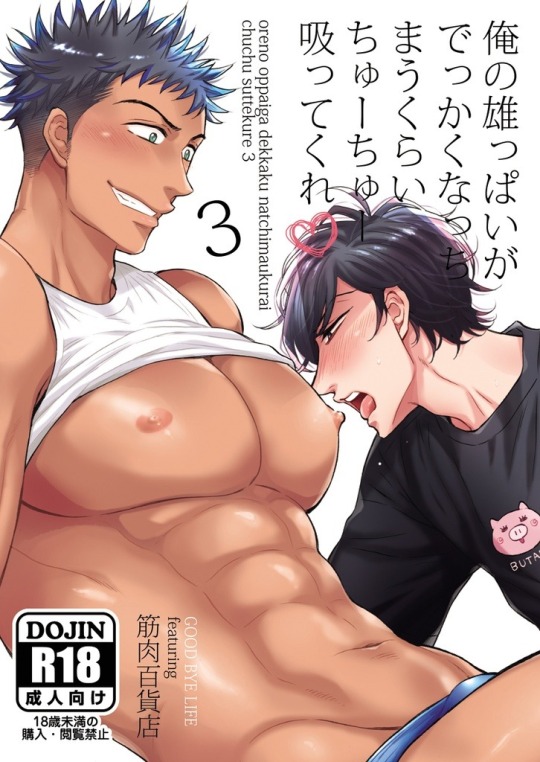
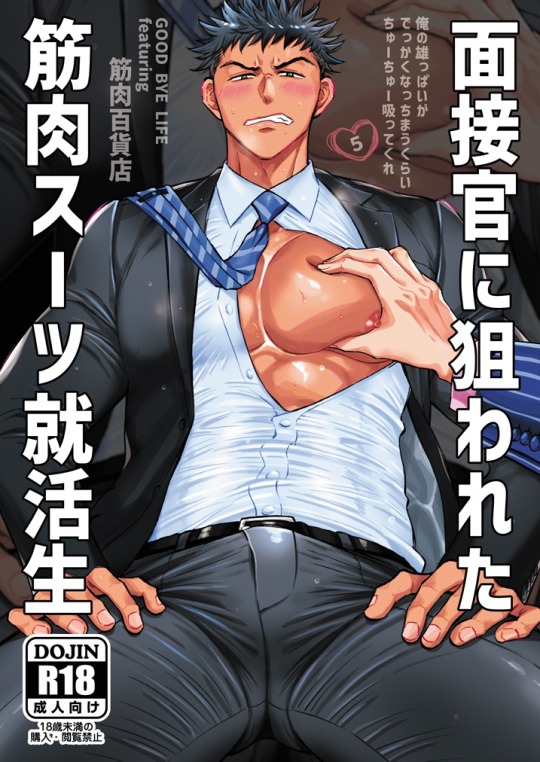
Apart from creating commercial BL and yaoi (self-published BL like the ones in the image given above), he has also authored an autobiographical work titled Shoujo Manga Artist Minamoto-San Comes Out and a manga exploring queer life and homophobia titled The Gay Who Turned Kaiju.
Moreover, many scholars, mangaka, fans, etc. from Asia and elsewhere have already spoken/written plenty about the issue of fetishization. Here's a compilation of resources.
3. zero critical consumption and leveraging of abusive concepts
I wonder why it is assumed that BL is consumed without critical thinking. It is true that BL, especially MAME's BL, are not didactic. TharnType is a BL with odo (royal road) narrative progression. It is not one of the sweet BL that GMMTV produces. Due to a general lack of BL literacies, there are off-the-mark expectations associated with BL, particularly Thai BL. Hence, odo BL seems to violate a lot of these misguided expectations.
TharnType is a well-done odo BL, in my opinion. "Leveraging of abusive concepts" is not a failure but a feature.
When it comes to depiction of abuse, there are those who think that it always gives the wrong message. There are variety in opinions on what is the right way to go about it. BL being an accommodating genre has space for all sorts of treatment. Even in live action, there is good variety in terms of how the theme is treated. But nothing is everyone’s cup of tea. This being the case it is understandable if someone like how MAME handles abuse, just as it is understandable if someone doesn't.
Assuming that fans don't engage critically with the theme and are mindlessly consuming it, have the implication of infantilizing the audience - as though they are without faculties of discretion and are incapable of making judgements. It also has the added implication of demonizing all media concerning queer people that deals with abuse. If MAME’s approach is deemed “unsafe” for queer population, based on that judgement, where does BL and gei comi that offer erotic treatment of abuse fall? What about queer people producing and consuming them?
That brings me to the points @nieves-de-sugui has raised.
4. how much all of these tropes where used (and still are). I believe that when things are made for tv they should take all the things you mentioned into account more than they do.
I believe that makers of live action queer content are very cautious. Thanks to that we are yet to get live action adaptation of any gei comi.
I have seen mainstream media ignore Gengoroh Tagame (probably the most popular gay mangaka creating content aimed at androphilic men) and his works for years in spite of his tangible influence on East Asian queer men. And then suddenly creating a live action adaptation of his all-ages manga My Brother’s Husband.
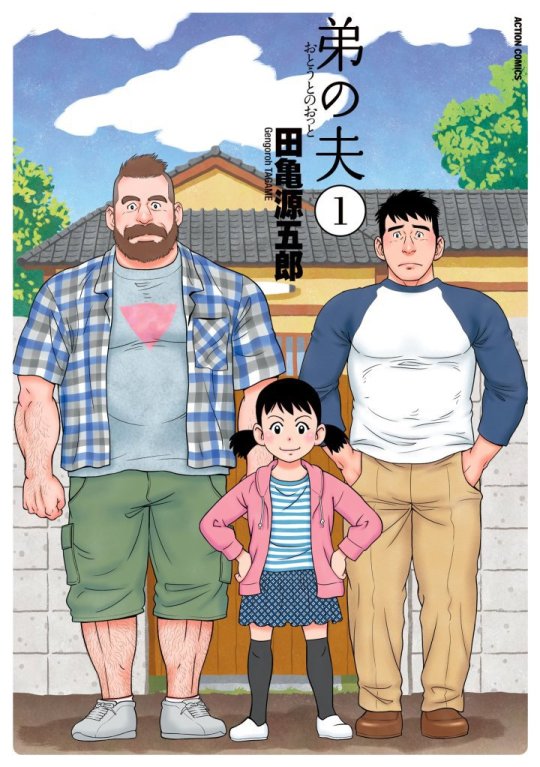
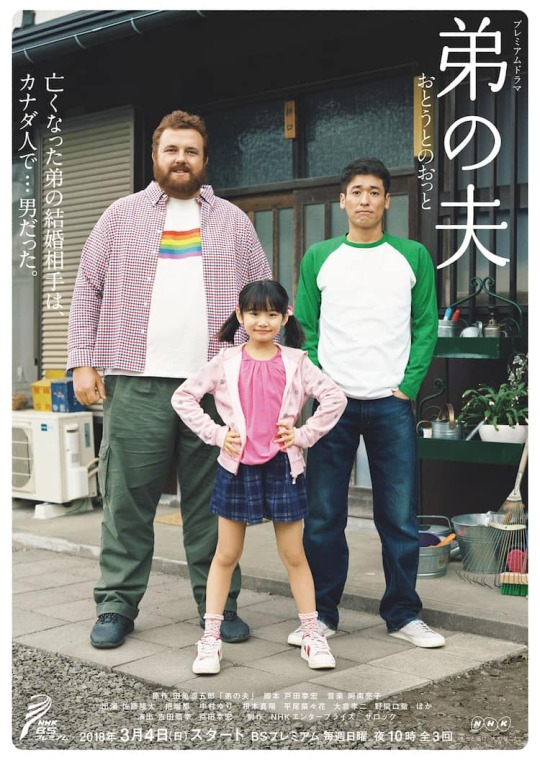
Who will dare to adapt his works Gunji or Fisherman’s Lodge or Pride? How can we show rape, trauma and taboo involving queer people on screen? What message will it give to the queer population? To the non-queer population?

A scene from Fisherman’s Lodge. Image courtesy of @finalatomicbuster.
If MAME was not involved in producing her BL, it is doubtful if it would have ever happened the way it did. Almost all BL adaptation is a censored adaptation, with notable exceptions like Sei no Gekiyaku. Recently, 25 Ji, Akasaka de (2024) removed complicated sexual content (including a dub-con episode) from the volume 1 of the manga, which was critical to the story and the couple’s development, in adaptation. Sukiyanen Kedo Do Yaro ka (2024) went as far as removing the more sexual second couple from the live action adaptation probably because makers thought it was better not to go anywhere near cruelty.
The first ever anime adaptation of a gei comi, Shin Yaranai ka based on Junichi Yamakawa's Kuso Miso Technique, is *sigh* disappointing to say the least.
youtube
I wanted to quickly mention What Did You Eat Yesterday yaoi version since @waitmyturtles mentioned the series.
5. What Did You Eat Yesterday
I want to highlight that What Did You Eat Yesterday was not a BL in publication. It was published in Morning, a conservative magazine for middle-aged men. This is what got a live action adaptation.
Fumi Yoshinaga has created a proper BL doujin series that includes content that couldn't be part of publication in Morning.
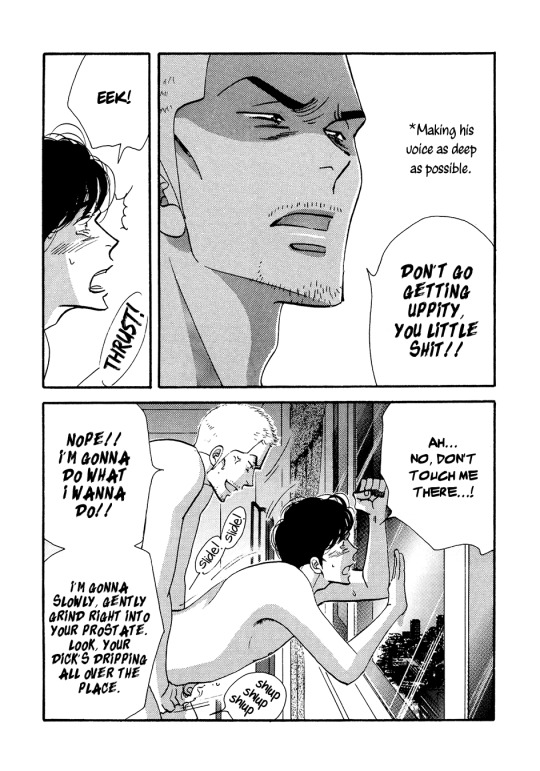


Here are some panels from the two latest volumes of the yaoi. I wonder if audience would have had the same impression of the show if they had incorporated the doujin bits too.
6. One piece of the puzzle that's missing here is Thai rape culture that blankets all of their society.
This is an important point @yousaygoodbyeandisay raised and it applies not just to Thailand.
Sexual assault as a theme in BL, handled in a myriad of ways, has been the case since the inception of the genre. I have discussed the history in the context of Japan here.
It was during the publication of JUNE magazine that the importance of depiction of sexual assault in BL became clear to the editor through response letters from readers.
June is a place of therapistic rehabilitation for those women who had experiences of mental and physical abuses as a female. Mr. Sagawa said that he cannot ignore that there are not a few readers who had such experiences during their childhood.
source
MAME studied BL and its production academically (you can find her research output by searching her name: อรวรรณ วิชญวรรณกุล) before she entered live action production. She not only know what she is writing/creating but also is willing to deal with difficult themes without taking sweet, fable-like route.
Now onto the points @mikuni14 raised.
7. my shock seeing so much SA related stuff (the show covered just about every problematic sex thing there is, and finally forgave the heinous criminal instead of putting him in jail. I don't know how MAME can create for example AePete and also somany vile things
For those who don’t know, MAME is a unique Thai BL creator. Thai BL creators on average lack BL literacies for various reasons. MAME is one of the exceptions. This is because:
she is a BL author & hence, one of the creators of BL literacies
she studied BL and its production academically [you can find her research output by searching her name: อรวรรณ วิชญวรรณกุล]
then she started producing live action BL
In an industry which is lacking in BL literacies, what she brings to the table is fu-culture (BL fan culture) in all its glory. Unfortunately, the live action audience who are fans of sweet BL, have a hard time adjusting.
Here are some typical narrative progressions for a (Japanese) BL:
あまあま – sweet
ユニーク – unique
シリアス – serious
邪道 – evil road (jadō)
王道 - royal road (odo)
Any theme/one-line plot can choose to take any of these narrative progressions. Moreover, Thai BL usually originates online which allows for innovation.
MAME employs different narrative progressions for different ships. AePete follows the typical sweet BL progression. KengklaTechno follows jado and TharnType odo.
TarTum is a sweet BL, complicated by them being step-brothers. While their pairing is barely on odo, Tum as a character has a complicated odo progression within their ship.
Since TharnType is an odo BL all wrong-doings are not punished. Take for example KinnPorsche, another odo BL, where the ending can’t be 'organized crime gets the main characters in jail'. In odo BL involving crime, most of the victims are usually cannon fodders. So, characters are not bothered much by the crime. But in MAME's universe, Tum is an important character, someone designed to make audience root for him. Hence the audience can’t dismiss the crimes against him. It is not wrong to want the narrative to have Lhong jailed. If TharnType was a sweet BL, it would have gone there.
8. selective memory
Selective memory is indicative of preferences and it helps to fine tune BL consumption. MAME's storytelling incorporates diverse elements. Those who enjoy her works also might find that there something or the other that isn't to their taste. This is an important part of BL literacies.
I enjoy dangerous characterizations over subdued ones and prefer a meriba more than a happy ending. While there are plenty of BL media with those, they are super rare in live action. So, I appreciate MAME for taking into account fans who want something different from sweet BL.
Here are the points @bengiyo raised:
9. What Did You Eat Yesterday v/s Old Fashion Cupcake
This has nothing to do with MAME but has to do with BL literacies more generally. Old Fashion Cupcake is more appealing to BL fans because it is a BL and hence not sanitized to continue run on a conservative magazine. So, it permeates moe (affect). Moreover, creators of Old Fashion Cupcake are better informed than creators of What Did You Eat Yesterday in terms of BL literacies. So, the direction and acting works better in the former than the latter.
9. The Effect feeling like the first huge volley leveled at BL from within the genre.
I am always amazed at the takes on the Effect. Somehow it is assumed to be a critique of BL genre. That's not the case. The Effect is a proper jado BL.
What audience are picking up on is the 'I can do it better' spirit that motivates a lot of BL creation. It is natural for audience to feel like the depiction of complex themes, such as sexual abuse, bullying, delinquency, identity theft, murder, infidelity, pregnancy, etc. are not dealt with well. Creating BL that fits one's taste better is one way authors and artists go about addressing the issue. That is how we end up with same theme dealt with in numerous ways. When that expands, we end up with sub-genres and BL categories.
Jado BL are rare, particularly in Thai BL.
It is difficult to sell BL with jado and other narrative progressions. It becomes even more difficult to sell branded pairings when the characters they play are not impeccable. It is unlikely that actors playing bad guys can sell products for advertisers. (Imagine the characters from The Effect being in ads together!) It is even more unlikely that fans would go broke behind wicked characters and would want to attend fan-meetings and concerts featuring them in some way.
This is also so as not to trouble the average audience’s worldview (世界観) and is clearly a low effort and low skill (in terms of BL literacies) approach. But since a lot of audience don’t appreciate villain-like characterization, it is clearly low risk, no chance of a backlash from angry audience and the best method for assured money making.
@respectthepetty has also flagged the next issue:
10. History3: Make Our Days Count.
Gays were being buried and put in prison in Taiwanese BLs in the same year it legalized marriage equality.
There is a lot of ethnocentrism in the hate that MODC gets, apart from lack of BL literacies. While I understand where that take is coming from given American media history in the context of Hayes code, AIDS crisis, etc., I wish media from elsewhere would be looked at independently.
Queer narratives everywhere have their own over-used tropes and historical issues. Malayalam media, for example, has the issue of having one of two queer characters having varathan vibe (Rosy in Ponnaranjanam, Kiran in Sancharram, Antony's boyfriend in Mumbai Police, Kiran in My Life Partner, etc.) that makes them look odd in Kerala's rurban landscape. Even Kaathaloram played into this trope. The problem is that it perpetuates the belief that queerness is an import of sorts.
Mindless application of media critique learned from the west leads to the brushing aside of pertinent issues with media of the region in favor of finding legitimacy via commonality with the west. That way we end up with crits accusing Moothon of employing bury the gay trope while ignoring that:
Moothon is a gangster action flick like Kammattippaadam
It is rare for romances irrespective of the gender of the main characters and genre of the movie to have happy ending in Malayalam. In fact, almost all great love stories in Malayalam movies are tragedies. This is unlike in Hollywood where heterosexual romances usually get happy endings.
more importantly, every queer character, including Latheef, is infused with varathan vibe.
Taiwanese BL has issues worth exploring. Issues of their own media - not varathan queer trope from Malayalam media or bury your gay trope from American media.
MODC was an dealing with well-established BL tropes (like any other show in the History franchise). It explored bereavement (a tribute to Lan Yu, first ever danmei live action adaptation) and substitute lover trope.
The series introduced a doppelgänger of Yu XiGu (Xiang HaoTing’s white moonlight), a perfect candidate for substitute lover trope. But instead of pursuing it, they subverted the trope.
History franchise, which was build to grow BL and BL literacy in Taiwan, ended up victim to prejudice since it failed to measure up to foreign standards. MODC offered something rare. The audience didn't appreciate it. They dismissed it for not measuring up to expectations colored by experiences which danmei is not connected with for historical reasons.
By that standard, would tongzhi literature from Taiwan too have to make amends for sins of the west towards its queers? Imagine stripping of death as a theme from tongzhi author Chiang-Sheng Kuo's works! Then there is also difference in how death is perceived in different societies.
Why must BL be arm-twisted to fit into norms from elsewhere and correct the wrongs of someone else?
11. BL profit off LGBT community
This is really interesting. There are many questions that I can think of that is linked to this take:
Is BL really profitable? Short answer is no. Long answer here.
Is it really LGBT community that BL profits off?
Probably not. It is moe that BL sells. That imo, is the main difference between BL and other queer genres.
Anyway, BL predates LGBT acronym. It predates de-pathologization of homosexuality in many BL creating regions. Fu-people were creating BL before mainstream media started representing queer people in media. Fu-people battled state and its censors everywhere along with queer people. Live action BL surely is commercialized. But that is capitalism reaping the dividends of decades of fu-people's labor of love.
@he-is-lightning-in-a-bottle raised the following point.
12. 2019 saw significant increase in quantity and quality of BL. Since then, live actions smoothed out the rougher edges of the source material (like what happened with Kinnporsche and Love in the Air).
While I understand the rational behind toning down dangerous characterization to appeal to the largest audience, I think that kind of censorship for commercialization limits potential of the genre. The impact is most visible in case of GMMTV BL such as Only Friend (where it could neither be sweet BL nor could it embark properly on jado).
Compare it with adaptation of the ero-BL Sei no Gekiyaku. It stayed true to the content and pushed the boundaries enough to bring about convergence between gay pinku cinema and BL. When BL is allowed to explore its potential freely, it not only imparts BL literacies but also makes it possible for other queer genres to gain new audience, which in turn encourages production houses to venture into different queer genres.
jjsanguine raised the following point.
13. I don't even hate toxic characters or plotlines, actually I love them. But like even if the characters don't know they're doing it, the show should. And it really really doesn't. And neither do the fans. Kind of alarming.
This is in relation to Lhong and San.
Lhong is a yandere in a odo BL. (for detailed discussion see Part 3) It is a matter of the world view and less about show's self-awareness (which I believe it has). If TharnType was an jado BL, Tharn could have ended up with Lhong and Type would be the stalking horse.
@jjsanguine later commented about how Lhong felt "goofy" by way of his over-the-top actions which made the show's convictions questionable.
San and Tharn's relationship was, to an extend, the most realistically depicted. I remember starting to learn about Thai queerness and realizing that a lot of elements in their relationship reads like ethnography. Consider for example Tharn being only fourteen at the time of sexual debut and San being older. This is not too different from the average age of sexual debut in Thailand. Despite it being a compoundable offense, average age of sexual debut is declining. Tharn's discovery of what he likes and dislikes and shedding cuteness (which San comments about) and adopting manliness (which Techno comments about) too is in line with what is observed among urban queer youth. Contrast this with Sky in Love in the Air whose sexual debut and exploitation are tied to his migration to urban landscape. Sky's backstory too read like ethnography and his vulnerability a reflection of the many others' in his society.
@absolutebl raised the following points:
14. Rape - as plot device - doesn't make good stories - lazy & bad writing: Feminist critique and modern narrative analysis.
Feminist and queer BL scholars from Akiko Mizoguchi to James Welker have discussed rape as a plot device in BL. Since experts have written plenty, I'll spare my effort discussing this misconception.
15. rape is an act of sexuality (or worse, sexy), it is NOT - it is an act of violence. But that is only the start to the way it’s chronically mishandled, especially in commercial fiction (of which romance makes the largest percentage).
Akiko Mizoguchi's two decade of work have addressed this in relation to Japanese BL which I feel holds true for BL more generally. Moreover, BL is not a romance sub-genre. BL is a genre in itself. A lot of BL is romance. There is enough overlap between those genres to give the impression that BL is a romance sub-genre. But there are plenty of other works too. Like One Room Angel and Social Reform Season. Similarly, BL is not a porn sub-genre. A lot of BL is porn. But come on!
16. [MAME] produces consistent highly-profitable narratives by-and-about queer folks but utterly disingenuous to the queer experience and that defines exploitation in the ET industry... Right, just adding that yes BL does not represent (in any way) the reality of being queer in any of these countries.
I have already discussed how MAME's works are intersectional reflections of queer experience. BL has been reflecting different queer experiences in Japan even before the term boys' love emerged. But narrow, ethnocentric ideas of queerness doesn't lend itself to honest understanding of other forms and representation. Consider characters being addressed as เมีย ‘wife’. It is a Thai queer practice. One can always dismiss that since it sounds heterosexist in the culture one comes from as absolutebl does in this post. That, imo, is 'disingenuous to the queer experience' of Thai people.
The question is what are westerners missing in their own countries' queer media that they feel they must just judge everything with no care for the cultures and people producing content for themselves? Seriously, what have the westernization done to some in the audience that they emerge so desperate for queer content that they watch BL yet remain blind to the cultures (fu-culture in particular) that produce them and splooge vitriolic ethnocentrism?
-
That concludes this discourse series. I want to sincerely thank everyone who contributed to and inspired this 🙏.
Other parts: Part 1 | Part 2 | Part 3
#mame#love sea the series#love by chance#tharntype#love in the air#wedding plan the series#love sea#bl thai#thai series#thai bl series#thai bl meta#thai bl#love in the air the series#bl tropes#bl trivia#bl literacies#asian lgbtq dramas#asian bl series#asian ql#bl meta#bl analysis#bl trope analysis#bl drama#thai ql#tropes#bara manga#gei comi#thai boys love#thai drama#asianlgbtqdramas
69 notes
·
View notes
Text
Trans Reads is an ambitious project created by and for transgender people to openly access writing related to our communities. We believe education should be free and writing shouldn’t be behind a paywall. Transreads.org provides the opportunity to access, discuss, and distribute texts for free.
If you’re looking for books, chapters, texts, essays, or articles by, for, or about people who transverse or transcend western gender norms, you’re in the right place!
Trans Reads was formed through the work, consulting, and creativity of an anonymous group of trans people of various genders and races around the U.S. involved in organizing, academia, and trans liberation efforts. Trans Reads was launched in 2019 following increasing violence against trans people alongside the lack of accessible resources for trans people to learn about our own community.
There is a serious barrier for most trans people accessing content from our community. Trans people on average have less disposable income, time to read and purchase literature, and knowledge of the available texts. We created Trans Reads to address this problem directly. We offer the largest collection of free trans texts on the internet.
Get Involved:
Trans Reads is almost entirely generated through user content. By uploading, you can help a trans teen in a rural area learn about other girls like her. You could help a trans student who can’t afford a textbook easily pass their class. You can even share your own writing with the world on an easy-to-use platform exclusively for trans content. You can help grow our collection on our upload page. If you are interested in helping us upload texts for our collection, you can reach out on our contact page.
Ethics:
We are faced with the common ethical question about hurting the sales of trans authors. However, the largest ever study on piracy actually found that the piracy of copyrighted books, music, video games, and movies has no effect on sales. In the case of video games, piracy actually helped sales. As far back as 2002, we can see piracy boosting sales of media. Trans Reads strongly encourages you to purchase the books that you enjoy here or find other ways to support the author.
Academic authors rarely – if ever – see income from sales of their books, articles, or chapters. Most want to remove the paywalls withholding their content. Trans Reads is open to collaborating with authors, publishers, and journals on making this a possibility through our website.
History:
In 2014, Leslie Feinberg published the 20th-anniversary edition of Stone Butch Blues, one of the most influential works of transgender literature. The novel was a way for trans, gender nonconforming, and queer people to realize ourselves. It told us we aren’t alone. However, when the publisher went bankrupt, Leslie had to struggle to regain ownership over hir own novel.
“I had to work to recover my rights to Stone Butch Blues. When the first publisher went into Chapter 11 court, I had to spend thousands of dollars of my wages on legal fees to recover the right to this novel… While very ill in Spring 2012, I recovered my rights again.”
Ze didn’t want the book to be released as a film adaptation exploiting hir story for straight fantasies. Ze also used the opportunity to make the book more accessible. First editions shot up into hundreds of dollars. The least expensive print versions are still over $30 on Amazon. This simply isn’t affordable to most queer and trans people. The fight ended with Leslie publishing hir novel on hir website as a PDF, a strategy of reclaiming transgender narratives from greedy publishes by collective ownership of the text.
Trans Reads is dedicated to the memory of Leslie and all those who feel alone. Most individuals don’t have institutional access and cannot afford to pay for texts. Transreads.org allows visitors to effortlessly read texts by, for, or related to trans people online for free as PDFs. Trans Reads is the space where anyone can easily discuss, add, or download trans content.
This project is intended to foster discussion around the current state of learning. We refuse paywalls and withholding education. Trans Reads provides the opportunity to access, discuss, and distribute texts related to our community on its website in a matter of seconds.
Knowledge, learning, and community must be de-commodified for our collective liberation. Take it from Leslie:
“And on the day those paper deeds of ownership are torn up, it won’t matter about protecting Stone Butch Blues anymore from commercial exploitation.”
Authors shouldn’t live in fear of their work being exploited or inaccessible. Trans Reads is just one small part of trans autonomy from corporate publishers. However, it is a necessary step toward engaging with our radical history, politics, and futures.
Click here to upload a text.
366 notes
·
View notes
Text
Those who wish to learn their Indigenous languages and earn a degree can do so without leaving northern Saskatchewan.
The Saskatchewan government announced more than $100,000 in funding for the First Nations University of Canada (FNUniv) to deliver new programs that will allow students to study for a bachelor of Indigenous education in their home community.
According to a release, the financial contribution will fund the new Dene Teacher Education Program (DTEP) in Hatchet Lake Denesuline Nation and the Cree Teacher Education Program (CTEP) in Waterhen Lake First Nation.
“Creating more opportunities for Indigenous students to access post-secondary education, particularly those living in rural and remote areas, is a priority for the Government of Saskatchewan,” said Advanced Education Minister Gordon Wyant in a media release. [...]
Continue Reading.
Tagging: @politicsofcanada
#cdnpoli#Saskatchewan#First Nations University of Canada#Indigenous politics#education#post secondary education
100 notes
·
View notes
Text
Thing to remember if you are writing anything involving class and working class people, including game design: poverty is a major cause of AND a major result of disability and chronic illness.
If you write something where every working class person, every person who comes from a working class background, or every poor person, is healthy and physically strong, and just as much or more so if you bake that into a game system by giving people from those backgrounds high Health or Strength stats, you are making an active *choice* to erase a substantial part of the experience of and results of poverty.
Disabled people exist *everywhere*. In every setting - even when there’s magical healing or nanobots or whatever, frankly, erasure of disabled people and the experience of disability is an active narrative choice to erase us. So we *certainly* exist in *every* real world present-day and historical setting, and the fact that you don’t think so is due to active cultural erasure of disabled people and the experience of disability.
While disability is *absolutely* present in every strata of society, the experiences of disability and poverty are deeply and inherently entwined. Given that the vast majority of people are workers, and primarily physical workers throughout history - and if you don’t think disability massively impairs your ability to do call centre work, let alone food service, care work, retail work, or most of the other low-paid jobs in our current service economy, even if they are not habitually classified as heavy physical work, you need to massively expand your understanding of what disability actually is.
Poverty is generational in all sorts of ways, but one of them is that gestational and childhood poverty affects a person for their entire life. There are so many illnesses that one is predisposed to by inadequate nutrition during gestation and childhood, or by environmental pollution during those times (most likely in poverty-stricken areas). Disability and illness in parents and family members so often sees young children go without essentials and older ones forced into forgoing education and opportunities so they can care for family members or enter paid work. It’s a generational cycle that has held depressingly true in urban and rural areas, and that’s before even considering the impact of genetic illnesses and predisposition to illnesses.
Not to mention that a great deal of neurodivergence is incredibly disabling in every strata of society - yes, bits of it can be very advantageous in certain places, jobs, roles and positions, but the *universality* of punishment for not intuiting the subtle social rules of place and social environment again and again means most ND folk end up with a massive burden of trauma by adulthood. On top of the poverty that means in loss of access to paid work and other opportunities, trauma is incredibly shitty for your health.
Yeah; it might not be “fun” to write about or depict. But by failing to do so you are actively perpetuating the idea that the class system, whatever it is, is “just”. That poorest people do the jobs they do because they are “best suited for them” instead of because of societal inequality and sheer *bad fortune* without safety nets to catch people. It is very much worth doing the work to put it in.
#disabled#disability#disableism#chronic illness#chronic pain#chronic fatigue#neurodivergence#child poverty#poverty#class#classism#history#writing#game writing#game design#generational poverty
118 notes
·
View notes